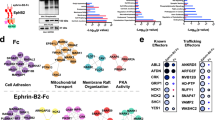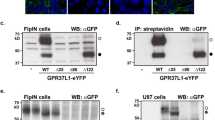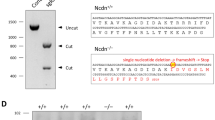Abstract
The trkC locus encodes catalytic and noncatalytic receptors, generated by alternative splicing. These primary high-affinity neurotrophin-3 (NT-3) receptors may act in concert to modulate responsiveness to NT-3. Signal modulation can also be achieved by receptors that are post-translationally processed. We report that the noncatalytic TrkC receptor, TrkCNC2, is cleaved at the membrane-proximal region of its extracellular domain. This generates a soluble ectodomain (gp90TrkCNC2) recovered in the cell culture medium and a membrane-bound fragment (p20TrkCNC2), which contains the transmembrane and intracellular regions including the juxtamembrane and the NC2-specific cytoplasmic domains. We also show that this processing, which does not occur in the TrkC catalytic counterpart, is upregulated by NT-3 and upon treatment with the tumor promoter 12-O-tetradecanoylphorbol-13-acetate. Moreover, cleavage inhibition after EDTA or 1.10 phenanthroline treatment suggests involvement of a metalloprotease(s). Finally, this post-translational processing was observed not only in TrkCNC2-overexpressing NIH3T3 cells but also in primary cultures of cortical neurons and brain extracts. This study shows that, in addition to alternative splicing, ectodomain shedding represents a novel means of regulating TrkC receptor signaling, and consequently NT-3 biological effects on target cells.
This is a preview of subscription content, access via your institution
Access options
Subscribe to this journal
Receive 50 print issues and online access
$259.00 per year
only $5.18 per issue
Buy this article
- Purchase on Springer Link
- Instant access to full article PDF
Prices may be subject to local taxes which are calculated during checkout





Similar content being viewed by others
References
Barbacid M . (1995). Curr. Opin. Cell Biol., 7, 148–155.
Biffo S, Offenhäuser N, Carter BD and Barde YA . (1995). Development, 121, 2461–2470.
Butowt R and Von Bartheld CS . (2001). J. Neurosci., 21, 8915–8930.
Cabrera N, Diaz-Rodriguez E, Becker E, Martin-Zanca D and Pandiella A . (1996). J. Cell Biol., 132, 427–436.
Clary DO and Reichardt LF . (1994). Proc. Natl. Acad. Sci. USA, 91, 11133–11137.
Diaz-Rodriguez E, Cabrera N, Esparis-Ogando A, Montero JC and Pandiella A . (1999). Eur. J. Neurosci., 11, 1421–1430.
DiStephano PS, Chelsea DM, Schick CM and McKelvy JF . (1993). J. Neurosci., 13, 2405–2414.
DiStephano PS and Johnson EM . (1988). Proc. Natl. Acad. Sci. USA, 85, 270–274.
Donovan MJ, Hahn R, Tessarollo L and Hempstead B . (1996). Nat. Genet., 14, 210–213.
Eide FF, Viing ER, Eide BL, Zang K, Wang XY and Reichardt LF . (1996). J. Neurosci., 16, 3123–3129.
Garner AS and Large TH . (1994). Neuron, 13, 457–472.
Götz R, Köste R, Winkler C, Raulf F, Lottspeich F, Schartl M and Thoenen H . (1994). Nature, 372, 266–269.
Hapner SJ, Boeshore KL, Large TH and Lefcort F . (1998). Dev. Biol., 201, 90–100.
Klein R, Conway D, Parada LF and Barbacid M . (1990). Cell, 61, 647–656.
Klein R, Jing S, Nanduri V, O'Rourke E and Barbacid M . (1991a). Cell, 65, 189–197.
Klein R, Nanduri V, Jing S, Lamballe F, Tapley P, Bryant S, Cordon-Cardo C, Jones K, Reichardt LF and Barbacid M . (1991b). Cell, 66, 395–403.
Lamballe F, Klein R and Barbacid M . (1991). Cell, 66, 967–979.
Lamballe F, Tapley P and Barbacid M . (1993). EMBO J., 12, 3083–3094.
Martin-Zanca D, Oskam R, Mitra G, Copeland T and Barbacid M . (1989). Mol. Cell. Biol., 9, 24–33.
Menn B, Timsit S, Calothy G and Lamballe F . (1998). J. Comp. Neurol., 401, 47–64.
Menn B, Timsit S, Represa A, Mateos S, Calothy G and Lamballe F . (2000). Eur. J. Neurosci., 12, 3211–3223.
Middlemas DS, Lindberg R.A and Hunter T . (1991). Mol. Cell. Biol., 11, 143–153.
Nilsson AS, Fainzilber M, Falck P and Ibanez CF . (1998). FEBS Lett., 424, 285–290.
Ninkina N, Grashchuck M, Buchman VL and Davies AM . (1997). J. Biol. Chem., 272, 13019–13025.
Pandiella A, Malgaroli A, Vicentini LM and Meldolesi J . (1986). FEBS Lett., 208, 48–51.
Schroeter EH, Kisslinger JA and Kopan R . (1998). Nature, 393, 382–386.
Shelton DL, Sutherland J, Gripp J, Camerato T, Armanini MP, Phillips HS, Carroll K, Spencer SD and Levinson AD . (1995). J. Neurosci., 15, 477–491.
Strohmaier C, Carter BD, Urfer R, Barde YA and Dechant G . (1996). EMBO J., 15, 3332–3337.
Tessarollo L, Tsoulfas P, Donovan MJ, Palko ME, Blair-Flynn J, Hempstead BL and Parada LF . (1997). Proc. Natl. Acad. Sci. USA, 94, 14776–14781.
Tsoulfas P, Soppet D, Escandon E, Tessarollo L, Mendoza-Ramirez JL, Rosenthal A, Nikolics K and Parada LF . (1993). Neuron, 10, 975–990.
Valenzuela DM, Maisonpierre PC, Glass DJ, Rojas E, Nunez L, Kong Y, Gies DR, Stitt TN, Ip NY and Yancopoulos GD . (1993). Neuron, 10, 963–974.
Vecchi M and Carpenter G . (1997). J. Cell Biol., 139, 995–1003.
Vecchi M, Rudolph-Owen L.A, Brown CL, Dempsey PJ and Carpenter G . (1998). J. Biol. Chem., 273, 20589–20595.
Yee NS, Langen H and Besmer P . (1993). J. Biol. Chem., 268, 14189–14201.
Zupan AA, Osborne PA, Smith CE, Siegel NR, Leimgruber RM and Johnson EM . (1989). J. Biol. Chem., 264, 11714–11720.
Acknowledgements
This work was funded by the Institut Curie, the Centre National de la Recherche Scientifique and by a grant from the Association pour la Recherche sur le Cancer to F.L. (no. 9802). S Mateos was supported by a fellowship from the French Ministère de l'Education Nationale, de l'Enseignement Supérieur et de la Recherche.
Author information
Authors and Affiliations
Corresponding author
Rights and permissions
About this article
Cite this article
Mateos, S., Calothy, G. & Lamballe, F. The noncatalytic TrkCNC2 receptor is cleaved by metalloproteases upon neurotrophin-3 stimulation. Oncogene 22, 740–745 (2003). https://doi.org/10.1038/sj.onc.1206213
Received:
Revised:
Accepted:
Published:
Issue Date:
DOI: https://doi.org/10.1038/sj.onc.1206213
Keywords
This article is cited by
-
SheddomeDB: the ectodomain shedding database for membrane-bound shed markers
BMC Bioinformatics (2017)
-
Proteolytic cleavages give receptor tyrosine kinases the gift of ubiquity
Oncogene (2009)
-
Stable expression of intracellular Notch suppresses v-Src-induced transformation in avian neural cells
Oncogene (2007)



